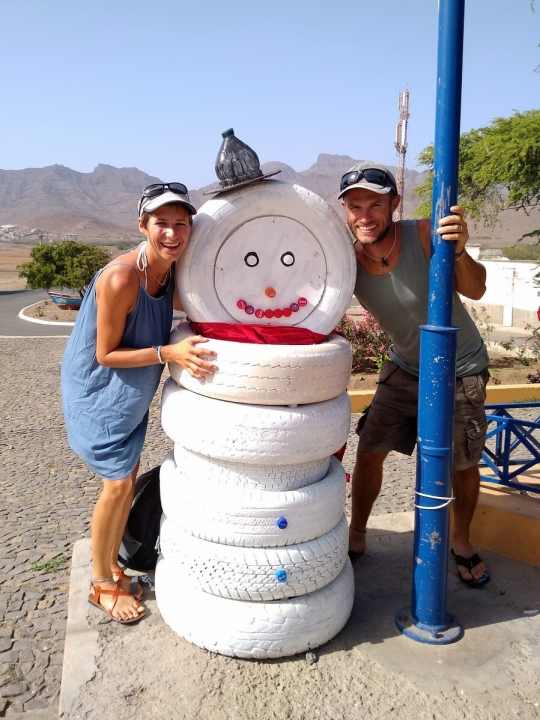
Cape Verdean New Year's greetings from the "Aracanga" crew! From southern Germany via the French canals and rivers, through the Mediterranean and via Morocco and the Canary Islands, Riki and Martin and their small yacht have now reached the island archipelago of Cape Verde. The islands, which are constantly buffeted by the trade winds, have a lot to offer, from dreamy sandy beaches on the uninhabited island of Santa Luzia to the lush green hiking paradise of Santo Antao. Anyone who sails here and only fills up with water and diesel in Mindelo has not seen Cape Verde. You should take the time to get to know the islands, the country and the people. It's worth it.
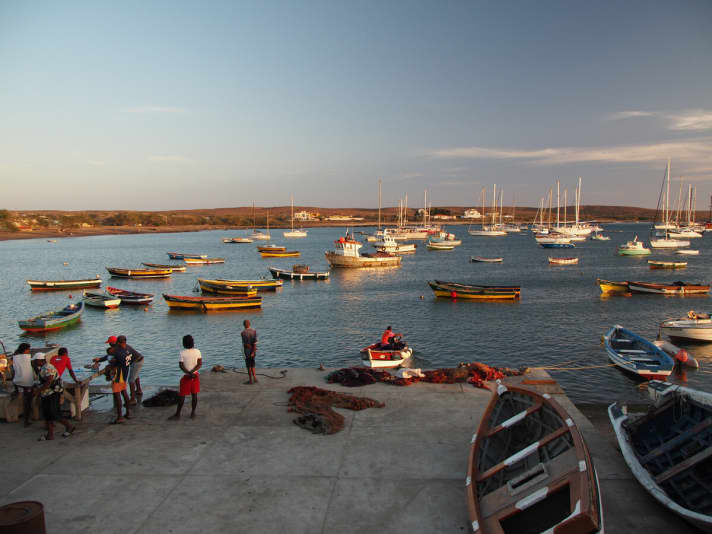
We've been travelling for almost six months now, and our "Aracanga", which until last year knew nothing but Lake Constance, is now sailing between the Cape Verde Islands off the west coast of Africa after logging over 3,000 miles. The 800 nautical mile crossing from the Canary Islands to the Cape Verde Islands was the highlight of the trip so far in terms of sailing: calm at first, then rough and later simply marvellously beautiful.
Lots of wind from behind
After two relaxed days of sailing, the wind picks up a little and pushes us strongly southwards. It's relatively warm - around 25 degrees - even though the strong wind makes it feel much cooler. With the wind, the waves have also increased to two and a half metres, and there are always big breakers of up to four metres in between.

Our little "Aracanga" is shaken up quite a bit and lurches from left to right and back again. We have only unrolled part of the genoa. That's enough to keep the boat on course at a speed of four to six knots.
A few days ago, you could still stand comfortably in the cockpit, one foot on the left and one foot on the right bench seat, leaning forwards on the sprayhood with a cup of tea. Sitting, wedging, bracing and holding on is the order of the day to avoid tumbling through the cockpit or the cabin. We still have 320 nautical miles to go to the north-easternmost Cape Verde island of Sal, and a good half of the 800 nautical miles are in our wake.
Logbook entry from 1 December 2018:
During the night it was windy and wavy, the wind picked up to around 25 knots from astern, and we kept surfing down high, breaking waves. Top speed: 10.7 knots. The "Aracanga" and the Aries windvane steering are doing a great job, we don't have to intervene once to keep the boat on course. The main has been down since the start of the crossing, we just vary the size of the genoa. On average, we make around 4.5 knots and over 100 miles every day, which is a good distance for our little one.

5 December 2018: Over the last few days, the crossing has become a real dream. It is warm, even really hot during the day, the wind and waves have decreased and the water is also slowly getting warmer. The short waves have given way to a long, pleasant Atlantic swell and the wind is blowing steadily from astern at 15 to 20 knots.
Ahead the Southern Cross
At night we have a starry sky, no more sightings of foreign boats during the night watches, but the Southern Cross in front of us and just barely the Big Dipper and the North Star behind us. While we saw virtually no animals until the day before yesterday, we are now regularly accompanied by dolphins playing in our bow wave and following glittering tracks behind us in the glow of the sea at night.
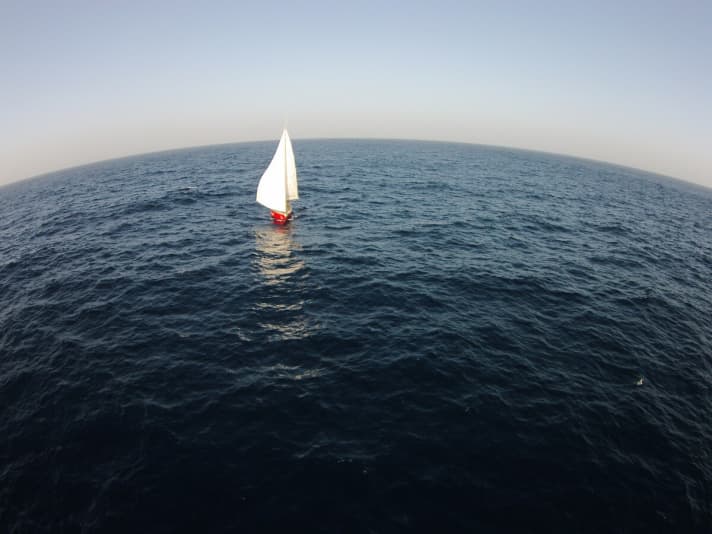
The "Aracanga" also paints a glittery trail in the sea, which disappears again in the waves a few metres behind the boat. There are a few birds out and about, mainly sandpipers and brown boobies, and we have also spotted a few sea turtles of impressive size. When we sail past them, they lift their heads curiously out of the water and look after us, just as we then stand curiously at the railing until the animal continues its journey and disappears again in one of the next waves.
Turtles, dolphins and flying fish
In the water, which is getting warmer every day, we also see flying fish again. If the fish "fly" just above the surface of the water for several hundred metres in daylight when fleeing from a predator, they shoot vertically upwards out of the water at night, which occasionally ends with a crash landing on deck. Last night, a specimen about ten centimetres long made a particularly neat emergency landing, namely right in one of the pockets next to the companionway and upside down in Riki's empty coffee cup, where it made a lot of noise until we freed it from its predicament.
We only find some of our less fortunate colleagues dried up on deck the next morning. The same goes for small octopuses, which, if you wouldn't believe it, can apparently jump quite high out of the water. But the most impressive encounter by far was a mighty sperm whale, significantly larger than the "Aracanga". The whale calmly swam past us just a metre away and examined us curiously. A little way behind our boat, it stretched its fluke into the air and dived down.
Arrival on St Nicholas' Day
On St Nicholas' Day, our anchor drops at sunrise in six metres of water in the bay of Palmeira. We have arrived in Cape Verde. While this is Riki's first visit to the islands, it's my third time here and I'm once again impressed by the archipelago.
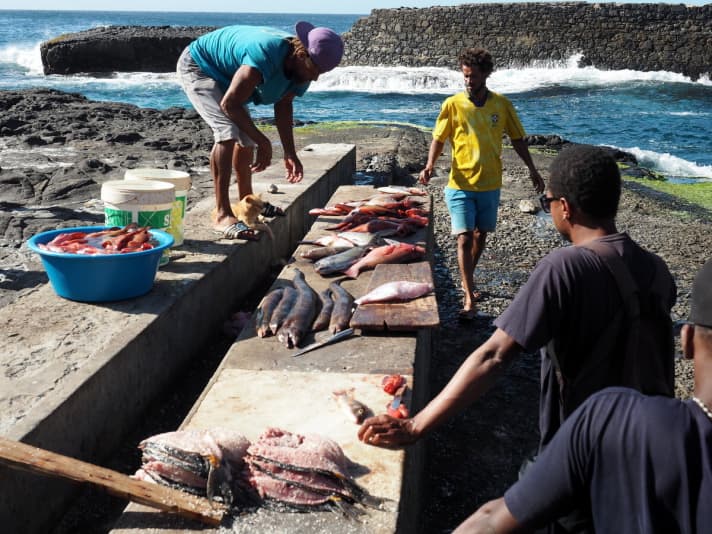
In addition to Sal, we visit the northern part of Cape Verde, the islands of São Nicolau, Santa Luzia, São Vicente and Santo Antão, although we travel to the latter by ferry due to the poor anchorages. The islands could not be more different. While Sal is a piece of Sahara in the Atlantic, with hardly any sights but a great atmosphere in the small, sleepy village of Palmeira, São Nicolau and Santo Antão are lush green and a dream for any hiking enthusiast.
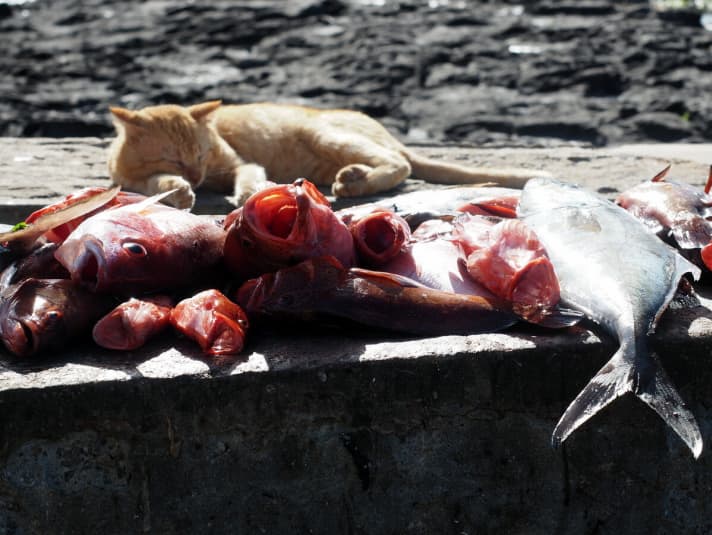
Cape Verde is our second destination outside of Europe, and as soon as we enter the harbour in Sal, we have the feeling of being far away. The colourful town of Palmeira quickly captivates us with its lively spirit and typical Cape Verdean no-stress mentality. The dock is also a playground, fishing harbour, fish market, shipyard and general meeting place. A handful of boys are already waiting for us here, all keen to earn a few cents and look after our dinghy. "Me Alessandro, me watch your dinghy" - "Okay."
Clearing in is quick and uncomplicated. Palmeira is Cape Verde's third official port of entry alongside the two larger cities of Mindelo and Praia and is actually known for the fact that entry formalities can take a few hours longer here. We are lucky and have the stamps in our passports after a quarter of an hour.

Once the work is done, the immigration officer has a coffee break with a long chat at the harbour bar, and the French single-handed sailor who arrived shortly after us has to come back in the afternoon to complete the entry formalities. "No stress, it's Cabo Verde."
Pure joie de vivre
Palmeira is great, the joie de vivre and hospitality of the Cape Verdeans as well as all the music and the colourful houses are unique, and for this reason alone the island is worth a visit. Jay, a local, is a self-appointed harbour master and has made it his job to look after the sailors and, where necessary, deliver water and diesel in his small fishing boat for a small fee, take away laundry and rubbish or simply drop by for a coffee, a beer or a chat. He also knows where to find local food and live music every day.

Palmeira is not a tourist resort, apart from the few cruising boats anchored here and a few pick-up trucks with visitors every morning. The evening music sessions are not staged for holidaymakers, but are simple and unadulterated, and nobody is bothered by faulty speakers or bright neon lights. You quickly find your way around and soon know which house is cooking on which day and when and where there is cachupa, rice with fish or rice with chicken for 250 escudos (approx. 2.50 euros).
We felt more than welcome and safe at all times here in Palmeira. It does involve handing a few escudos to one of the guys at the harbour for looking after the dinghy, but this is more of a nice gesture than a need for safety, as you often meet the same kid half an hour later kicking a ball around in the streets.
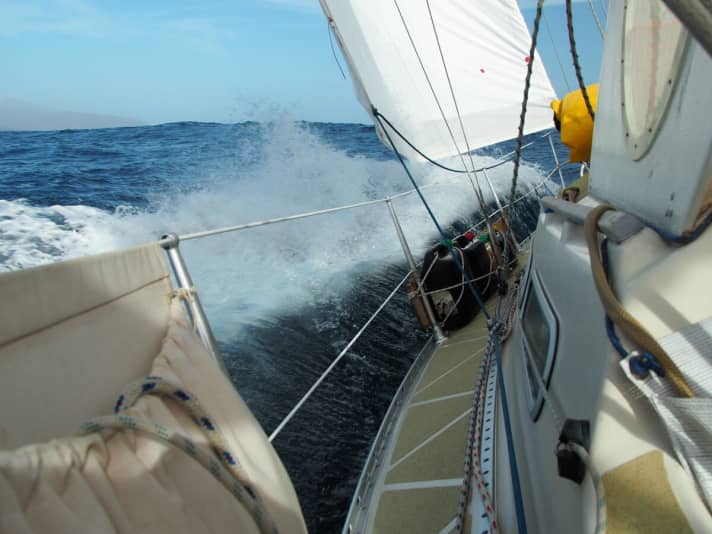
A few planned days on Sal have turned into ten days at anchor, and once again we blame the weather, because it has been blowing hard for four days, a five-metre swell has built up outside and the wind has covered our entire boat with a fine layer of reddish-brown sand. But at some point it was time to weigh anchor and head west.
Next island, next happiness
90 nautical miles west of Sal lies the island of São Nicolau, where after 20 hours of sailing with a steady shifting wind, the anchor drops in front of the village of Tarafal. São Nicolau is a mountainous island with barren, volcanic rocks on the coast and a green interior. The island is rarely visited by tourists and has retained its original character, which you notice as soon as you moor your dinghy at the fishing harbour in the small village of Tarrafal. Here, large tuna and mahi mahis are delivered by small, partly non-motorised fishing boats, cut up and sold directly on the quay. Next door is the fruit and vegetable market, where bananas, papayas and all the fruit that grows on the island are on sale.
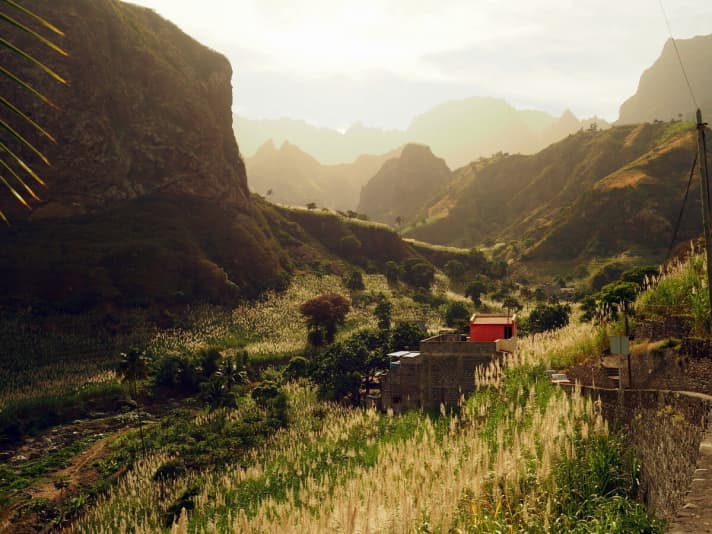
However, we only stay on São Nicolau for three nights, as we have arranged a date with our friends from the "Stray" on the neighbouring island of Santa Luzia. So the next day we head over to the uninhabited island. The short crossing is windy with a short, steep wave from the side, but only 25 nautical miles long. After a good five hours of sailing and a magnificent mahi mahi on the fishing rod, we anchor off the long sandy beach in six metres of water.
The island offers us good protection from the waves, but the jagged rocks and valleys increase the wind, which blows down the slopes with gusts of up to 45 knots. We give a good anchor chain, and our new bow anchor proves its worth again here. Our friends arrive in the evening, and after three weeks we have a big reunion with freshly caught fish and a cold beer.
Plenty of fish
Santa Luzia not only has a great beach with crystal-clear water and fantastic rocks for snorkelling, but is also popular with the local fishermen due to its abundance of fish. As we climb back into our dinghy after snorkelling and row back to our boats, one of the friendly fishermen appears next to us and, grinning, throws two freshly harpooned, wriggling perch into the boat. Before we can say thank you, he has disappeared again.
From Santa Luzia to São Vicente we have perfect sailing conditions for our little one. With one reef in the main and the genoa slightly reefed, we sail downwind between the two islands, sometimes with three knots of counter-current, then with a strong pushing current along the north coast of the island and into the large bay of Porto Grande, Mindelo.
Sailing here is a bit like coming home. I was in Mindelo in 2010 before we set off across the Atlantic from here on the "Ivalu", and our course crossed here for the first time in 2013, completing the circumnavigation.
In Cape Verde you have to clear in and out on every island, and after an unsuccessful attempt to clear in Mindelo - "That's not possible, it's friday afternoon, then it's weekend and afterwards it's christmas. Come back next week..." - we threw ourselves into city life, met up with old friends after many years and explored Mindelo with its many bars, colourful markets and omnipresent live music.
It's great to be here again. In Mindelo, we celebrate Christmas and New Year's Eve together with thousands of people and loud live music in an exuberant atmosphere on the street and soak up the lifestyle to the full.
The city of Mindelo and its anchorage are reasonably safe, but burglaries and thefts still occur from time to time and the usual caution is required, just like in any other major city in the world. The dinghy should be locked up or, even better, left on deck at night, the outboard motor locked, and gold chains and watches left on board. The same applies to Praia in the south of Cape Verde. As an alternative to anchoring, Mindelo is the only marina in Cape Verde where you can safely leave your boat.
Green paradise
The island of Santo Antão is only a stone's throw away from Mindelo. However, due to the poor anchorage, we leave the "Aracanga" in Mindelo and take a ferry trip to the neighbouring island. Santo Antão is lush green, mountainous and is an insider tip among hikers. Sugar cane, papaya, mango, breadfruit, maize, yams, agave, bananas, cabbage, carrots, apples and countless other plants are cultivated here in terraces. Even areas that are barely accessible and only a few square metres in size are used to grow fruit and vegetables.

We stay on the spectacular green island for two days, and two extensive hikes and many metres in altitude later it's just a case of putting our feet up - after such a long time on board, you do realise that your calves could do with a bit more exercise.
Anchor up, course for Africa
For us, the order of the day is "anchor up" and, for a change, "course east": instead of sailing westwards from here to the Caribbean, our next destinations are Senegal and The Gambia. We are very excited to see what awaits us there. We will then cross the Atlantic towards South America in February or March.
The "Aracanga" crew Riki and Martin wish you a good start to a great new year and "fair winds and following waves" at all times.
Further information, pictures and articles on the voyage of the "Aracanga" at Ahoy.blog.
